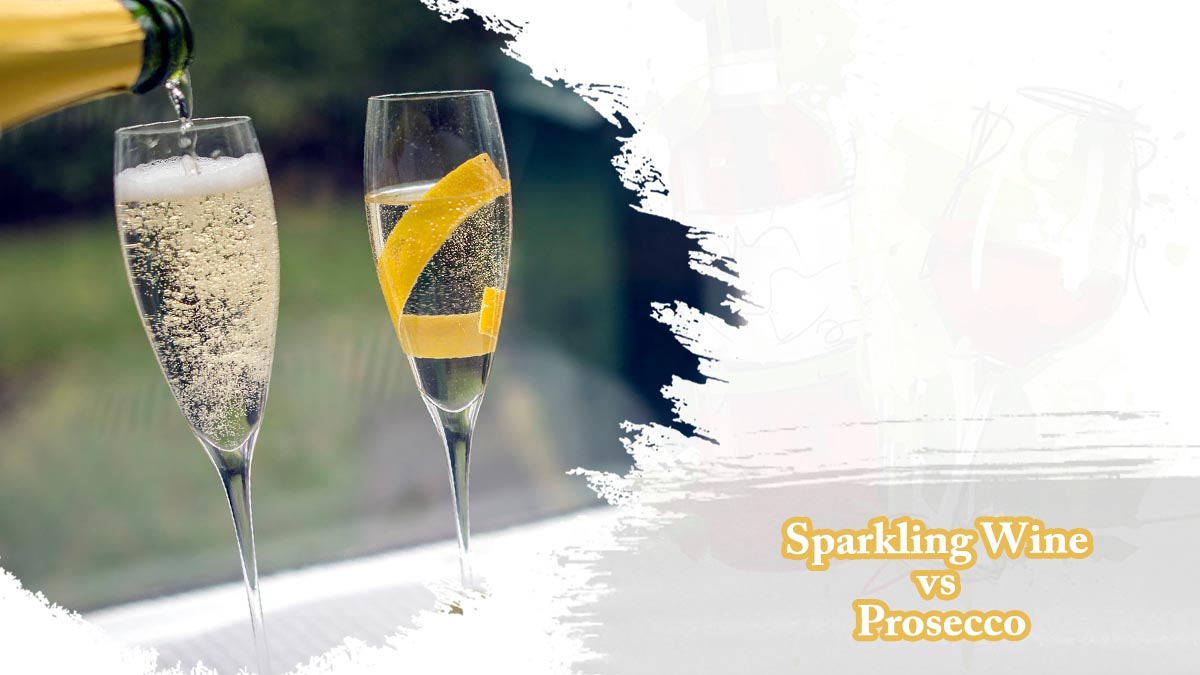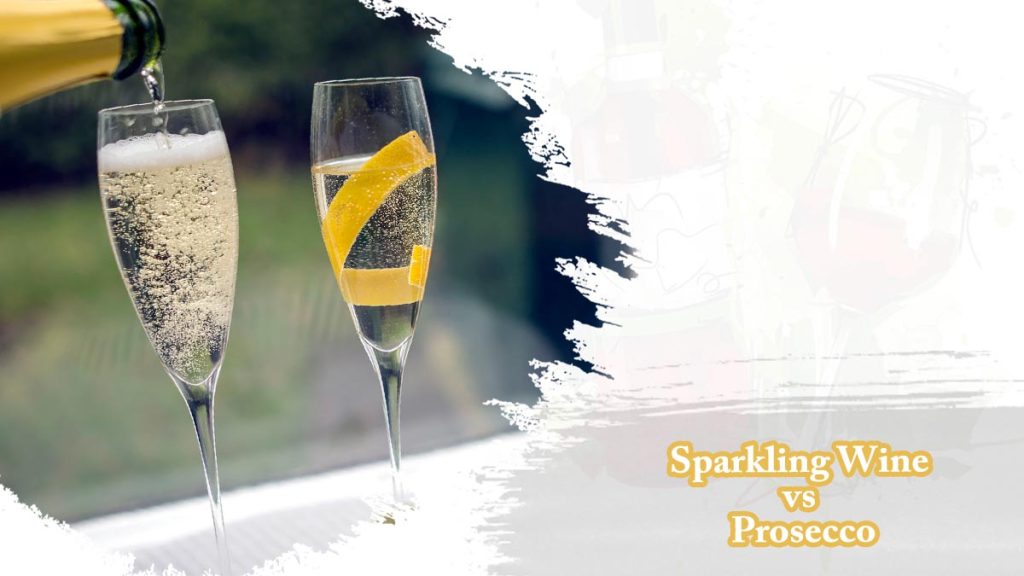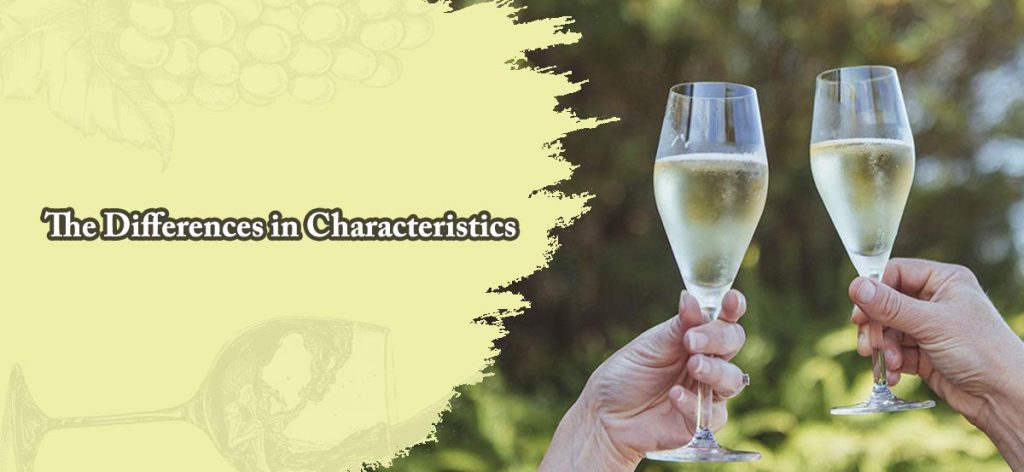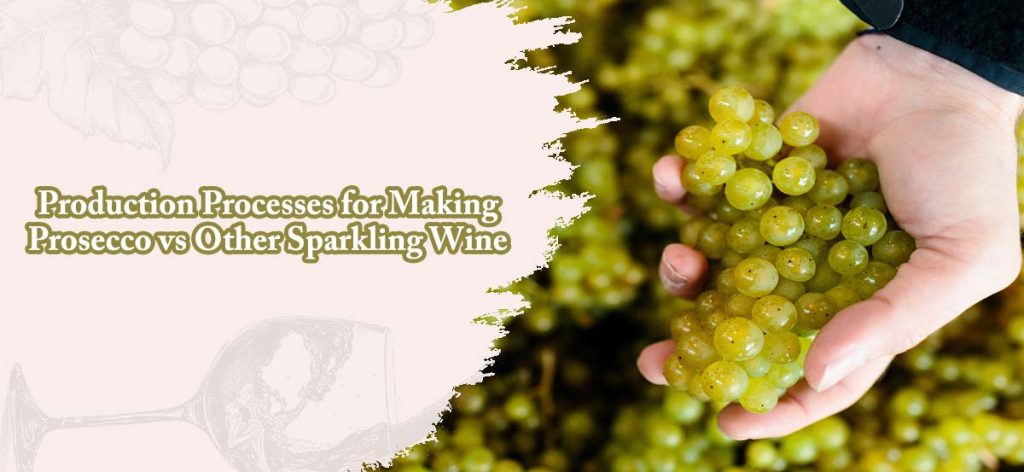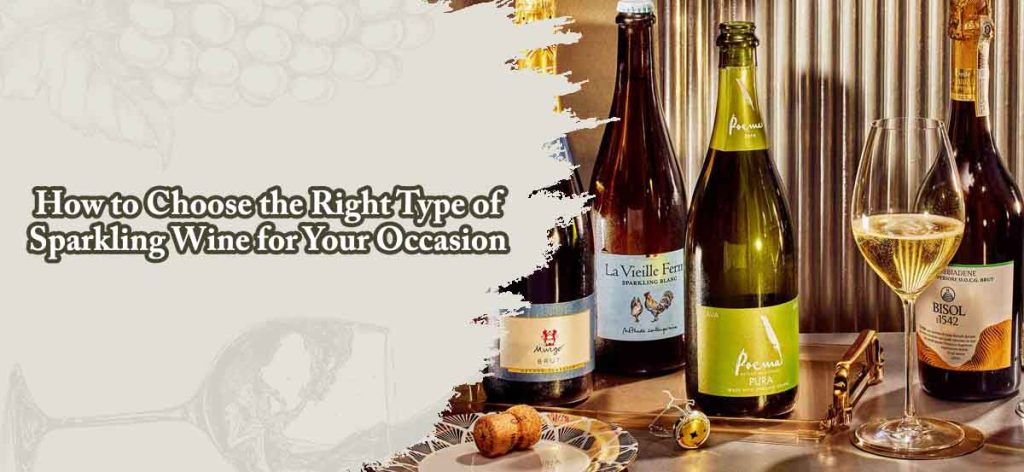Sparkling Wine vs Prosecco
If you are a beginner drinker, you may find that Prosecco has a lot of bubbles in it. And one fine day, you learn (or hear someone say) that sparkling wine is a type of wine with foam inside. So, you wonder if Sparkling Wine vs Prosecco is the same, what are the differences between them?
Prosecco is a sparkling wine, sparkling wine is a word used to refer to wine with air bubbles inside, and Prosecco is the name of an Italian white wine. It is also often referred to as a sparkling wine because of its characteristics.
That is a short answer for readers who want to compare Prosecco and Sparkling Wine to see where it differs. But this post is not only possible, later we will learn specifically about Prosecco as well as other Sparkling Wines. Continue reading together!
An Overview of Other Sparkling Wine vs Prosecco
Who doesn’t love bubbles? Whether you’re celebrating a special milestone or simply enjoying a casual lunch with friends, nothing quite elevates the occasion like a glass of bubbly. While there are many types of sparkling wines available, today we’ll be focusing on two popular types: Prosecco and Sparkling Wine. In this blog post, we’ll explore the origin, taste, production, and food pairing of both Prosecco and Sparkling Wine. So, grab a glass, and let’s dive in!
Prosecco is a popular type of sparkling wine that is produced in the Veneto region of Italy, specifically in the hills of Valdobbiadene and Conegliano. Unlike Champagne, Prosecco is made using the Charmat method, where the secondary fermentation (the process that creates the bubbles) is done in a large tank before being bottled. This results in a lighter, fruitier, and more refreshing taste compared to Champagne. Prosecco is known for its floral and fruity aroma, with notes of green apple, pear, and citrus. It is best served chilled and pairs well with light and refreshing foods such as seafood, salads, and cheeses.
Sparkling wine, on the other hand, refers to any type of wine that has bubbles. Unlike Prosecco, there are many types of Sparkling Wine, the most famous of which is Champagne. Champagne is produced in the Champagne region of France and is made using the traditional method, where secondary fermentation happens in the bottle. This results in a more complex and sophisticated taste, with notes of brioche, toasted almonds, and a creamy texture. Champagne is best served chilled and pairs well with rich and decadent foods such as caviar, foie gras, and lobster.
Apart from Champagne, other popular types of Sparkling Wine include Cava from Spain, Sekt from Germany, and Franciacorta from Italy. Cava is made using the traditional method and is known for its bright and refreshing taste, with notes of green apple, lemon, and almond. Sekt, on the other hand, can be made using different methods, including Charmat, tank fermentation, and traditional method, resulting in different taste profiles. Franciacorta is a lesser-known type of Sparkling Wine that is produced using the traditional method in Lombardy, Italy. It is known for its elegance and complexity, with notes of white flowers, citrus, and hazelnuts.
Whether it’s Prosecco or another Sparkling Wine, the effervescence, aroma, and taste of bubbly never fail to add a touch of indulgence to any occasion. While Prosecco is perfect for those who prefer a lighter, fruitier taste, Sparkling Wine, especially Champagne, is ideal for those who want a more sophisticated and complex experience.
The Differences in Characteristics between Prosecco vs Other Sparkling Wine
Prosecco is a sparkling wine, but it’s different from the others. If you’re a wine enthusiast or just curious about these popular beverages, read on to discover the subtle and not-so-subtle differences between Prosecco and other sparkling wines (here will explore the two The most popular ones are Champagne and Cava.)
Appearance: Let’s start with the most visible aspect – appearance. Prosecco, Champagne, and Cava each have their unique hues and bubbles. Prosecco has a lighter and more delicate appearance with frothy and fine bubbles. Champagne is often a pale gold color, and the bubbles tend to be smaller, more numerous, and last longer than Prosecco. Cava, similar to Champagne, often looks paler than Prosecco, but it may have a green hue. Cava has a lighter, more abundant bubble pattern.
Aroma: The aroma of the sparkling wine can also vary between Prosecco, Champagne, and Cava. When poured, Prosecco releases floral notes, including pear and apple fragrances. Champagne has a spicier, sweet aroma, offering hints of citrus and yet having a smokier profile. Finally, Cava often produces an aroma that blends fragrances of dried fruit, such as those of apricot, and nuts like almond and hazelnut.
Taste: The most exciting part of exploring different sparkling wines is the taste. Prosecco, Champagne, and Cava provide unique sensations to your taste buds. For the most part, Prosecco is a lighter-bodied wine that is fruity, floral, and crisp. It has a lower alcohol content, typically around 12%. Champagne, on the other hand, is medium-bodied, with a richer flavor that delivers both sweet and acidic sensations. Finally, Cava is known to have a higher acidity, lighter body, and flavor profile closer to that of Champagne; try the Cavas that have more lees contact and longer aging for richer flavors similar to Champagne.
Timeline: When it comes to aging, Prosecco and Cava are both fermented in stainless steel vats for a few months only. Therefore, they are meant to be drunk fresh and are not ideal for aging, but they are great for toasting on special occasions, pairing with appetizers and light food, or simply enjoying al fresco activities. Champagne, in contrast, must be aged for at least 15 months and up to several years, which is one of the primary reasons for its higher price point.
This extended time in contact with dead yeast cells, called lees, develops its rich flavor profile and aroma, which is significantly more complex than that of the other two. With Champagne, you are not limited to a drink for toasting but can explore what pairs well with the intricate flavor profile.
There are notable differences in appearance, aroma, flavor, and aging between Prosecco and other sparkling wines. Each drink provides its unique sensations, making them ideal for different occasions, preferences, and dishes.
Know more: Champagne vs Sparkling Wine.
To Bubbles or Not To Bubbles: Food Pairings for Prosecco vs Other Sparkling Wine
Bubbles always make a celebration more festive, but did you know that the right food pairing can take a glass of sparkling wine to the next level? With so many variations of sparkling wine, it can be hard to know what pairs best with what. Today, we’re going to dive into the world of sparkling wine and explore the best food pairings for Prosecco and other popular sparkling wines.
Prosecco is a sparkling wine that originates from the Veneto region of Italy. Prosecco typically has a lighter body with notes of green apple, lemon, and honeysuckle. It pairs well with crispy fried foods, seafood like shrimp cocktails, and fresh fruit. A classic pairing is with a charcuterie board featuring salty meats like prosciutto and parmesan.
Champagne, on the other hand, is a sparkling wine that originates from the Champagne region of France. It is known for its toasty, biscuity flavor profile and fuller body. Champagne pairs well with rich and buttery foods like lobster and oysters, as well as creamy cheeses like brie and camembert.
Cava is a sparkling wine from Spain and has a flavor profile similar to Champagne but is typically less expensive. Cava pairs well with savory foods like roasted chicken, grilled vegetables, and cured meats like chorizo.
Prosecco and other sparkling wines also pair well with sweet desserts. The bubbles can help to cut through the richness of desserts like chocolate truffles, cheesecake, and crème brûlée. A sweet Moscato d’Asti would also make for a great pairing with a fruit tart or fruit-based dessert.
When in doubt, pairing sparkling wine with salty and fatty foods tends to be a safe bet. The bubbles in the wine help to cleanse the palate between bites and refresh your taste buds. Additionally, sparkling wine can be flexible with food pairings due to its acidity, which can complement a wide variety of flavors.
In conclusion, with its light, crisp flavor profile, Prosecco pairs well with food like crispy appetizers, seafood, and fruit. Champagne, on the other hand, pairs well with rich and buttery foods like lobster and creamy cheese. Cava pairs well with savory foods like roasted chicken and grilled vegetables. Finally, when it comes to pairing sparkling wine with dessert, it’s tough to go wrong with Moscato d’Asti.
Production Processes for Making Prosecco vs Other Sparkling Wine
Sparkling wines are the ultimate celebratory drink. They add sparkle to our most joyous moments and are known worldwide for their glamour and allure. There are countless types of sparkling wine, each with its distinct style, taste, and production process. We’ll explore the production processes of Prosecco and compare them with other sparkling wine methods, such as Champagne and Cava.
Prosecco is made in the Veneto region of northern Italy, using the Glera grape. The production process for Prosecco is known as the Charmat method, where the secondary fermentation happens in a pressurized stainless steel tank over 30 days. The Charmat method is incredibly efficient and economical, making it a popular choice among wine producers. Due to its less complex production process, Prosecco is generally less expensive than other premium sparkling wines.
In contrast, Champagne, one of the most popular types of sparkling wine, undergoes a complex and time-consuming traditional method. Champagne is typically a blend of Chardonnay, Pinot Noir, and Pinot Meunier grapes. After the initial fermentation, a mixture of sugar and yeast is added, and the wine is bottled, put in contact with the dead yeast cells for a minimum of 15 months, and then disgorged. Finally, a dosage is added, which determines the wine’s sweetness to balance acidity, alcohol, and tannins. This process results in high-quality champagne but often requires years of aging, making it expensive.
Cava is another method of sparkling wine production, originating from Catalonia, Spain. Cava is typically a blend of local varieties like Macabeo, Xarello, and Parellada. The Cava production method is similar to the traditional champagne method but is less time-consuming. After the secondary fermentation, the wine is aged for a minimum of nine months in the bottle and then disgorged like champagne. Due to low production costs, Cava is generally less expensive than Champagne but can rival it for quality and is an excellent alternative.
Italian sparkling wine, Franciacorta, is also produced using the traditional method like Champagne, but it’s made from different grape varieties, such as Chardonnay and Pinot Nero. The production process involves a minimum of 24 months of aging and is nothing short of the complexity and attention to detail required for producing Champagne. The only difference is the replacement of the Champagne region’s unique soil and weather conditions with Italy’s.
Sparkling wine production processes vary greatly in complexity, timelines, and techniques. Whether you go for the affordable and refreshing Prosecco or the luxurious and expensive Champagne, each type of wine has its distinct charm and character.
Understanding Pricing Differences Between Prosecco and Other Sparkling Wine
When it comes to sparkling wine, many of us assume that all bottles are created equal. However, this is far from the truth. One particular sparkling wine variety that has been rapidly gaining popularity in recent years is Prosecco. Often touted as the cheaper alternative to Champagne, Prosecco seems to be the go-to choice of many shoppers looking for a sparkling wine that doesn’t break the bank. But why is this? Here, we’ll take a deep dive into the pricing differences between Prosecco and other sparkling wines.
One of the main reasons why Prosecco is typically less expensive than other sparkling wines, such as Champagne or Cava, is due to the way it’s produced. Prosecco is made using the Charmat method, which involves a second fermentation taking place in large stainless steel tanks. This method is much cheaper and less time-consuming than the traditional method used to make Champagne, which involves fermentation in individual bottles, extended aging, and hand riddling to remove yeast sediment. As a result, Prosecco can be produced more quickly, and with fewer steps, which makes it more affordable to produce.
Another factor that contributes to the lower price point of Prosecco is its production location. The vast majority of Prosecco is made in the Veneto region of northeast Italy, a place where land and labor costs are relatively low. By comparison, Champagne is made in a small region in northeastern France, where land prices are high, and labor costs are more expensive than in other parts of the country. As a result, Champagne production costs are naturally higher, which is reflected in the price of the final product.
When it comes to grape varieties, Prosecco is made primarily from the Glera grape, with small amounts of other local grape varieties added for flavor. This grape variety is relatively easy to grow, ripens early, and is highly productive, which means that growers can yield more grapes per acre, making the production of Prosecco more cost-effective. By comparison, Champagne must be made from a specific blend of grapes, with Chardonnay, Pinot Noir, and Pinot Meunier being the three main varieties used. These grapes are more difficult to grow and have lower yields, making production costs more expensive.
In addition to the above factors, it’s important to note that the branding and marketing of sparkling wine can also affect its price point. Champagne, for example, has a long history of being associated with luxury and sophistication, which has contributed to its high price tag. Prosecco, on the other hand, is often marketed as a fun and affordable alternative to Champagne, with a focus on celebration and enjoyment rather than exclusivity. As a result, Prosecco is often priced lower than Champagne, despite being an excellent sparkling wine in its own right.
As we’ve seen, there are several reasons why Prosecco is typically less expensive than other sparkling wines such as Champagne. From its cost-effective production methods and grape varieties to its branding and marketing, these factors all play a role in determining the final price of the wine. However, we believe that price shouldn’t be the only factor when it comes to choosing a sparkling wine. Each wine has its unique flavor profile, and what might be an excellent choice for some people might not be the right fit for others.
How to Choose the Right Type of Sparkling Wine for Your Occasion
Sparkling wine is a versatile beverage that can add a touch of elegance and fun to any occasion. Whether you are hosting a formal dinner party, celebrating a special event, or just enjoying a casual evening with friends, there is a sparkling wine that will suit your needs. With so many different types of sparkling wines available, choosing the right one can be overwhelming. Here are some tips to help you select the perfect type of sparkling wine for your occasion.
1. Know the different types of sparkling wines
Before we dive into the tips, let’s go over the different types of sparkling wines. The most famous type is Champagne, which is made exclusively in the Champagne region of France. Other popular types include Cava (from Spain), Prosecco (from Italy), and Sekt (from Germany). Each type has its unique flavor profile and production process, so it’s essential to understand the differences to make an informed choice.
2. Consider your budget
Sparkling wines can range from budget-friendly to several hundred dollars per bottle. Set a realistic budget for your occasion and look for wines that fit within that range. Keep in mind that the price does not always indicate the quality of the wine. There are excellent sparkling wines available at a reasonable price point, so do your research before making a purchase.
3. Think about the occasion
The type of sparkling wine you choose should reflect the occasion. For example, if you are hosting a romantic dinner, you may want to choose a high-end Champagne to set the mood. If you are celebrating a festive occasion such as New Year’s Eve or a wedding, a refreshing Prosecco or Cava may be a better fit. Consider the theme and tone of the event, as well as the guests’ taste preferences.
4. Pair wine with food
Sparkling wine can be a fantastic pairing option with food, so consider the menu when selecting a wine. In general, dry sparkling wines like Brut or Extra Brut are versatile and can go well with a variety of dishes, including seafood, poultry, and cheese. Sweeter wines like Demi-Sec and Sec pair well with desserts and can balance out spicy dishes.
5. Experiment with new wines
Finally, don’t be afraid to try new types of sparkling wine. There are many lesser-known varieties available that can be surprisingly delightful. Experimenting with new wines is part of the fun of being a wine enthusiast.
Sparkling wine can make any occasion more special, but choosing the right type can be challenging. Keep in mind the different types of sparkling wines, consider your budget, and think about the occasion and food pairing. Finally, don’t be afraid to experiment with new wines. With these tips in mind, you’ll be able to select the perfect sparkling wine for any occasion.
Uncorking the Bubbles: Discovering the Fascinating World of Sparkling Wine
What comes to your mind when you hear the term “sparkling wine?” Champagne? Prosecco? Cava? Moscato? Sparkling wine is so much more than a fancy drink that you pop open only on special occasions or New Year’s Eve. There is a whole world of sparkling wine that is worth exploring. Now, we will take a closer look at some interesting things about sparkling wine that you probably didn’t know before.
1. Champagne is not the only sparkling wine
While Champagne is undoubtedly the most well-known type of sparkling wine, there are many others worth trying. For instance, Prosecco, made from Glera grapes in Italy, is an excellent alternative that is known for its light, fruity and refreshing taste. Cava, which is produced in Spain, is made from native Spanish grapes and is considered to be an excellent value for the quality of the wine. Lambrusco, on the other hand, is a red sparkling wine from Italy that is perfect for those who love a fruity and sweeter taste.
2. The sound of the cork popping is not a sign of quality
While the popping sound of a cork opening may make us feel like we are opening a high-quality bottle of sparkling wine, it does not necessarily guarantee it. The sound means that there is pressure inside the bottle, which is a good thing, but it has nothing to do with the quality of the wine itself. Some excellent sparkling wines come with a twist-off cap or a cork that does not make a sound.
3. Sparkling wine can be paired with various foods
Sparkling wine is an incredibly versatile drink that pairs great with many different types of food. For instance, Champagne goes well with oysters and caviar, while Prosecco is an excellent choice for pairing with fried appetizers and spicy foods. Dry sparkling wines like Brut are also perfect for pairing with cheeses, sushi, and white meats like chicken and turkey.
4. The bubbles in sparkling wines come from a second fermentation process
Sparkling wine gets its bubbles from the carbon dioxide produced during its second fermentation. This process is different from that of still wine, and it is what sets it apart. Once the wine has undergone its primary fermentation, it is bottled with additional sugar and yeast, which then ferments again in the bottle, producing carbon dioxide. The carbon dioxide is trapped inside the bottle to create the bubbles that we all love.
5. Sparkling wine is perfect for celebrations but also great for everyday moments
While sparkling wine is often associated with special occasions, it doesn’t always have to be. A glass of bubbly can add some excitement to your everyday life, whether you’re enjoying a meal at home or having a picnic in the park. You don’t need an excuse to crack open a bottle of sparkling wine and enjoy its crisp, refreshing taste.
Sparkling wine is an excellent drink that is worth exploring beyond the realm of Champagne. With its versatility in pairing with various foods and its ability to make daily moments special, there is no better time than now to explore the world of sparkling wines.
FAQs
What is the difference between sparkling wine and Prosecco?
The main difference between other sparkling wines and Prosecco is that Prosecco is made predominantly from the Glera grape variety, with a small fraction of other local grapes permitted in its production. Additionally, Prosecco’s bubbles are smaller and less aggressive than those of other sparkling wines. The wine has a sweeter flavor and aroma compared to some of its more full-bodied counterparts. It also has a low alcohol content making it a light and refreshing beverage for social situations.
What type of grape is used to make Prosecco?
Prosecco is primarily made from the Glera grape variety, a highly aromatic and flavorful variety native to Italy. The grapes have very thin skins that allow for a lighter and more delicate flavor in the finished wine. While other local grape varieties are permitted in Prosecco production, Glera must make up at least 85% of the total blend. This ensures that Prosecco meets its classification as an Italian sparkling wine, with specific regulations on production and labeling.
Is sparkling wine or Prosecco sweeter?
Overall, Prosecco has a sweeter flavor and aroma than sparkling wines made from other grape varieties. This is because the Glera grapes used to make Prosecco contain higher levels of natural sugar, resulting in a sweeter final product. Additionally, Prosecco is generally less acidic than other sparkling wines, resulting in a smoother and more balanced taste. The distinct sweetness of Prosecco comes from its low-alcohol content which allows for more of the natural sugars to be retained during fermentation. As such, Prosecco can be enjoyed as a refreshingly sweet drink without the harsh bitterness associated with other sparkling wines.
How long does it take for Prosecco and sparkling wine to mature?
Prosecco and other sparkling wines typically take between six weeks and a year to mature. The production process starts with the fermentation of the grapes, where the sugar is converted into alcohol. This process usually takes between two weeks and a month, depending on the type of wine being produced. After this stage, the still wine is blended with carbon dioxide to create bubbles and then aged for several weeks or months in tanks before it is bottled. Prosecco does not require secondary fermentation in the bottle like Champagne, so it matures more quickly than many other sparkling wines.
The aging process helps to give Prosecco its distinctive flavor profile by allowing the flavors from the grape skins to blend with those from fermentation and maturation. In general, this results in a sweeter and more aromatic sparkling wine that can be enjoyed sooner than traditional sparkling wines.
Are all sparking wines from Italy labeled as “Prosecco”?
No, not all sparkling wines from Italy are labeled as Prosecco. While Prosecco must be made predominantly with the Glera grape variety, other Italian sparkling wines may use different varieties of grapes or a blend of several varieties. For example, the popular sparkling wine Franciacorta is made from Chardonnay and Pinot Noir grapes and is only produced in certain parts of Lombardy in Northern Italy. Other Italian sparkling wines like Asti and Brachetto d’Acqui are made from different types of Muscat grapes. All of these Italian sparkling wines have distinct flavor profiles that set them apart from Prosecco.
Does the amount of bubbles affect the taste of sparkling wine or Prosecco?
The number of bubbles in sparkling wine or Prosecco can affect the taste of the beverage. Bubbles create the carbonation that gives sparkling wines their signature effervescence, and too many bubbles can overwhelm the delicate flavors of the Glera grapes used to make Prosecco. The amount of carbon dioxide in sparkling wine is also responsible for how light and refreshing it tastes on the palate. If there are too few bubbles or if they dissipate quickly, then it would not have as much flavor or body as desired. Additionally, more bubbles mean more acidity which can make a wine taste more tart and acidic than desired.
To create a balanced sparkling wine or Prosecco, producers must carefully monitor and control the amount of natural sugar present in the Glera grapes used to make their wines. This helps ensure that there is an appropriate level of sweetness which helps to balance out any acidity from excess carbon dioxide. Additionally, producers may add a small amount of yeast during fermentation to help regulate the production process and properly release carbon dioxide without overwhelming other flavors in the finished product.
Ultimately, having an ideal ratio between sugar and bubbles ensures that each bottle of Prosecco or sparkling wine has its unique flavor profile that will best reflect its origin and grape variety.
Which has higher alcohol content, Sparkling Wine or Prosecco?
Prosecco generally has a lower alcohol content than other types of sparkling wines, typically between 11 and 12%. Other sparkling wines such as Champagne and Cava tend to have higher alcohol levels ranging from 12.5% to 14%, although some can be even higher than this. This is because Prosecco is made with only the Glera grape variety, which has lower sugar content, resulting in lower levels of alcohol after fermentation.
In addition, some producers also add additional sugar during fermentation or bottling to create sweeter styles of Prosecco that can mask any bitterness associated with higher alcohol levels. This is not possible with other sparkling wines since adding sugar would disrupt the secondary fermentation process necessary for these wines to obtain their signature bubbles. As a result, sparkling wines produced outside of Italy tend to maintain higher levels of alcohol than Prosecco due in part to their production methods.
Conclusion
In conclusion, we have covered the differences between Prosecco and Sparkling Wine. Prosecco is almost exclusively made in Italy using the Glera grape, while sparkling wines can be made anywhere with a range of indicia grapes. Other sparkling wine has more complex flavors and aromas because it’s aged for longer periods than Prosecco, making it more expensive as well.
To finalize things, Prosecco is actually a type of sparkling wine, but it requires specific production methods in Italy to be labeled correctly. No matter what type of bubbly you end up bringing to your next gathering or celebration, it’s important to know the nuances of other sparkling wines and Prosecco for different occasions.
Thanks again to all readers for joining this journey in comparing and contrasting sparkling wines versus Prosecco. Now go have some fun with bubbly drinks!
Visit our Website for more interesting post.

I am Thomas Delange, CEO of McMahon’s Public House bar. I have a passion for restaurants and cooking & wines, and I love to spend my free time experimenting in the kitchen. I’ve worked hard to make McMahon’s one of the most successful bars in the city. When I’m not working, I enjoy spending time with my friends and family.

